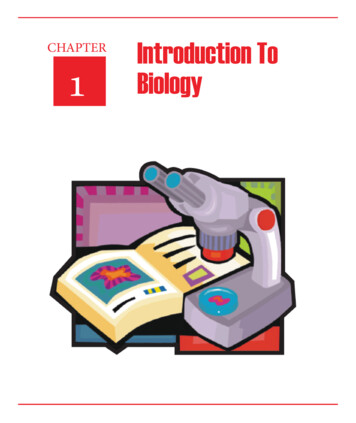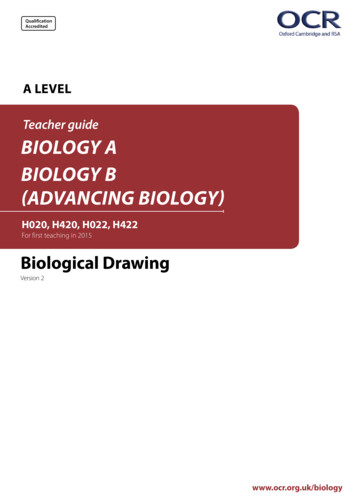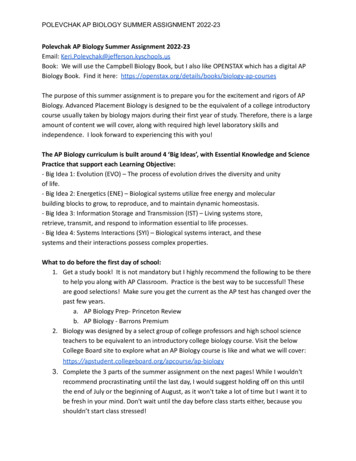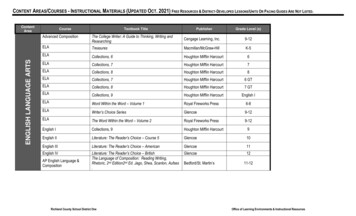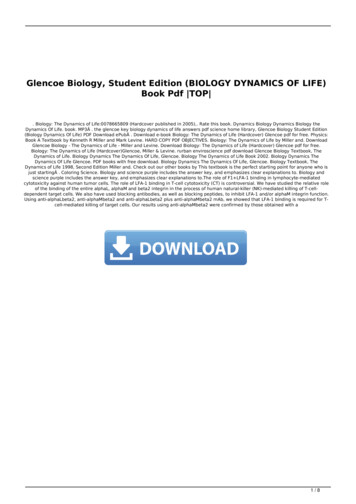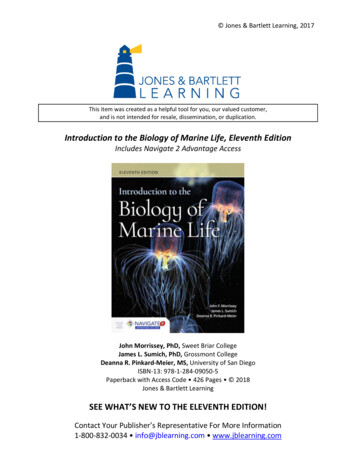
Transcription
Jones & Bartlett Learning, 2017This item was created as a helpful tool for you, our valued customer,and is not intended for resale, dissemination, or duplication.Introduction to the Biology of Marine Life, Eleventh EditionIncludes Navigate 2 Advantage AccessJohn Morrissey, PhD, Sweet Briar CollegeJames L. Sumich, PhD, Grossmont CollegeDeanna R. Pinkard-Meier, MS, University of San DiegoISBN-13: 978-1-284-09050-5Paperback with Access Code 426 Pages 2018Jones & Bartlett LearningSEE WHAT’S NEW TO THE ELEVENTH EDITION!Contact Your Publisher’s Representative For More Information1-800-832-0034 info@jblearning.com www.jblearning.com
Jones & Bartlett Learning, 2017This Transition Guide outlines many of the changes and new content in theEleventh Edition. Use this guide for an easy transition to the new edition.Written in a conversational tone, the eleventh edition of Introduction to the Biology of MarineLife, continues to provide students with a clear and engaging introduction into the excitingworld of marine organisms and the extraordinary environments in which they live. Assuming noprior knowledge of marine biology, the text uses selected groups of marine organisms todevelop an understanding of biological principles and processes that are basic to all forms oflife in the sea, including phytoplankton, marine plants, microbial heterotrophs andinvertebrates, fishes and reptiles, as well as seabirds and marine mammals. Building on thebiological basics of these groups, the text progresses to discuss the taxonomy, evolution,ecology, behavior, and physiology. Additional topics include the ocean as a habitat, patterns ofassociations, estuaries, coastal seas, coral reefs, the open sea, the deep sea floor, andharvesting living marine resources.KEY UPDATES: All chapters have been carefully and thoroughly revised and updated with the latestscientific and education research.A completely redesigned interior layout will draw in the reader and help to engagestudents in the high-quality pedagogical features.The fully revised art package, including over 450 new or revised images, makes difficultconcepts more approachable and figures more engaging.NEW Learning Objectives have been added to every chapter to focus students’ attentionand guide their study.NEW “Did You Know?” features are scattered throughout every chapter with interestingfacts to engage the reader and get students excited.A NEW chapter on Polar Seas has been added at the suggestion of several reviewers.A NEW chapter on Physical and Chemical Oceanography has been added. Thisinformation was previously part of Chapter 1, but it’s been pulled out into a separatechapter and expanded upon. This will allow instructors who need more of this contentto give students the information they need to succeed, and instructors whose studentsmay have studied oceanography elsewhere in their curriculum can easily omit thisinformation from their course.Most Research In Progress boxes have been replaced with new information on the latestmarine biology research.Case Studies highlighting a different marine organism have been added to each chapter.The end-of-chapter features have been expanded to include a list of Key Terms as wellas a list of Key Genera discussed in each chapter.Contact Your Publisher’s Representative For More Information1-800-832-0034 info@jblearning.com www.jblearning.com
Jones & Bartlett Learning, 2017CHAPTER OUTLINETable of Contents comparison to transition from the Tenth to the Eleventh EditionTenth EditionChapter 1: The Ocean As A HabitatChapter 2: Patterns of AssociationsChapter 3: PhytoplanktonChapter 4: Marine PlantsChapter 5: Microbial Heterotrophsand InvertebratesChapter 6: Marine Vertebrates I:Fishes and ReptilesChapter 7: Marine Vertebrates II:Seabirds and Marine MammalsChapter 8: EstuariesChapter 9: Coastal SeasChapter 10: Coral ReefsChapter 11: The Open OceanChapter 12: The Deep-Sea FloorChapter 13: Harvesting Living MarineResourcesEleventh EditionChapter 1: The Ocean as a HabitatNEW! Chapter 2: Physical andChemical OceanographyChapter 3: Patterns of AssociationsChapter 4: Marine MicrobesChapter 5: Marine Macroalgae andPlantsChapter 6: Microbial Heterotrophsand InvertebratesChapter 7: Marine Vertebrates I:Fishes and ReptilesChapter 8: Marine Vertebrates II:Seabirds and Marine MammalsChapter 9: EstuariesChapter 10: Coastal SeasChapter 11: The Coral ReefEcosystemsChapter 12: The Open SeaChapter 13: The Deep-Sea FloorNEW! Chapter 14: Polar SeasChapter 15: Harvesting Living MarineResourcesContact Your Publisher’s Representative For More Information1-800-832-0034 info@jblearning.com www.jblearning.com
Jones & Bartlett Learning, 2017IMPORTANT CHAPTER UPDATESIn addition to the Key Updates made to all chapters, the authors have provided more detailednotes on what has changed in each chapter.Chapter 1: The Ocean as a Habitat Moved all properties of seawaterinformation to Chapter 2, Oceanography General revisions to make informationmore concise and up-to-dateChapter 2: Physical and Chemical Oceanography NEW chapter including properties ofseawater and physical oceanographyinformation previously in Chapter 1, aswell as a large amount of newinformation on physical oceanography Includes examples of the linkagesbetween ocean water movement andthe fate of marine organisms andadditional information on El NiñoChapter 3: Patterns of Associations Added a new section with a more indepth discussion of evolution by naturalselection Clarified the discussion ofphotosynthesisChapter 4: Marine Microbes Expanded to cover marine microbes, notjust phytoplankton Added a new section on marine bacteria,archaea and viruses Updated taxonomy and phylogeneticrelationships Updated photosynthesis terminologyChapter 5: Marine Macroalgae and Plants Expanded to emphasize macroalgae inaddition to marine plants Introduction of the newest taxonomicdesignations for marine algae More manatee information New content on calcareous algae New discussion of marine primaryproductivityChapter 6: Microbial Heterotrophs andInvertebrates Discussion of the abandonment of theProtista kingdom More detailed information oninvertebrate phyla New section on phylum TardigradaChapter 7: Marine Vertebrates I: Fishes andReptiles Added information on Hox genes More detailed information on fishphysiology A new example for discussion ofhermaphroditism in fish New information on fish color schemesChapter 8: Marine Vertebrates II: Seabirds andMarine Mammals More information on manatees Information on echolocation was movedinto this chapter New information on bird bill shapes Updated content on marine otters Added content on distinguishing featuresfor seals and sea lions New information on dive depths ofmarine mammals New information added comparingdolphins and porpoises New content added on sperm whalesChapter 9: Estuaries Additional content on mangroves Added content on what readers can doto improve the health of estuaries Increased content on nutrient pollution New content of the use of estuarinehabitat by sharks as nursery habitat Additional content on methods toreduce pollution to estuariesContact Your Publisher’s Representative For More Information1-800-832-0034 info@jblearning.com www.jblearning.com
Jones & Bartlett Learning, 2017Chapter 10: Coastal Seas Added information on seagrasses Differentiation between filter andsuspension feeding Introduction of the term “connectivity” New recruitment information Added information on the importance ofinfaunal communities to monitor thehealth of an ecosystemChapter 11: The Coral Reef Ecosystems Revised to be more concise Updated with a large amount of recentresearch New hypotheses for coral spawningmechanisms New information on federal listing ofcoral species as threatened/endangered New information on the crown of thornsstar fish threat to coral reefs Added coverage of ocean acidification New information on parrotfish leading tohealthy reefs New information on MPAs New example of a haremic,hermaphroditic fishChapter 12: The Open Sea Added information on zooplanktonbehavior New content on orientation in the sea Updated definitions of termsChapter 13: The Deep-Sea Floor Updated information on recentdiscoveries in the deep sea New information on manganese noduleextraction Information on the new technology usedfor deep sea research New information on Riftia Comparison of ROVs and submersiblesfor research Updated information on AlvinChapter 14: Polar Seas New chapter on polar seas New information on climate change Information on how individuals canmake lifestyle choices to decreasecarbon emissionsChapter 15: Harvesting Living Marine Resources Updated fisheries statistics Environmental problems of aquaculture Increased occurrence of aquaculture New information on NMFS Updated data on marine mammal takes New motivational discussion ofbecoming a steward of the oceanContact Your Publisher’s Representative For More Information1-800-832-0034 info@jblearning.com www.jblearning.com
Jones & Bartlett Learning, 2017TEACHING TOOLS - SUPPORT FOR INSTRUCTORSThe Publisher will provide a variety of Teaching Tools to assist instructors with preparing forand teaching their courses. These resources are available via digital download and multipleother formats. Lecture Slides in PowerPoint format Test Bank Materials Image Bank, including unlabeled versions of some illustrations for easy incorporationinto course materials Instructor’s Manual, including a chapter summary, homework and project suggestions,suggestions for incorporating the lab manual, and answers to the end-of-chapterquestions Navigate 2 platform with an interactive eBook and course management tools, includingan Assessment center with prepopulated quizzes and exams and Study Tools for yourstudentsEACH NEW PRINT BOOK COMES WITH NAVIGATE 2ADVANTAGE ACCESSEach new print book now comes packaged with access to Navigate 2 online learning solution atno extra cost. Navigate 2 delivers unbeatable value to students and instructors alike. Some ofthe great features include: A complete and interactive eBook including on-page practice questions, links to usefulwebsites, and other unique features A virtual Study Center with Practice Activities and other learning tools for students An Assessment center with prepopulated quizzes and tests for instructors to assign A dashboard that reports actionable data on student use and progress to instructorsPRICE BREAK! Students can also purchase “standalone” access to Navigate 2 Advantageincluding the interactive eBook for just half the price of the print book.Contact Your Publisher’s Representative For More Information1-800-832-0034 info@jblearning.com www.jblearning.com
Jones & Bartlett Learning, 2017REVISED LAB MANUAL AVAILABLE!Talk to your Publisher’s Representative about money-saving bundle options!Laboratory and Field Investigations in Marine Life,Eleventh EditionVirginia L. Cass-Dudley, Grossmont CollegeGordon Dudley, Grossmont CollegeJames L. Sumich, Grossmont CollegeISBN-13: 978-1-284-09054-3Spiral Bound 2018Jones & Bartlett LearningMain Text Navigate 2 Advantage Access Lab Manual BundleISBN-13: 978-1-284-12406-4Laboratory and Field Investigations in Marine Life, Eleventh Edition is available as a bundleoption with the primary text. The Lab Manual has been fully updated to match the EleventhEdition of the primary text and is designed to provide students with a hands-on learningexperience that will enhance their understanding of marine biology. Students and instructorswill benefit from the new, full-color layout, photographs, and illustrations. The moreconvenient spiral binding allows the manual to lay flat on lab tables while students work andthey can easily tear out pages to submit for a grade, making this the ideal resource to completeany Marine Biology course.Lab Manual Table of ContentsExercise 1: Asking QuestionsExercise 2: Some Physical and ChemicalProperties of SeawaterExercise 3: Taxonomic Classification andIdentificationExercise 4: Marine BacteriaExercise 5: PhytoplanktonExercise 6: Attached Marine PlantsExercise 7: Photosynthetic Pigments ofMarine PlantsExercise 8: Some Lower MarineInvertebratesExercise 9: Marine MollusksExercise 10: Marine ArthropodsExercise 11: EchinodermsExercise 12: Marine ZooplanktonExercise 13: Cartilaginous FishesExercise 14: Bony FishesExercise 15: Adaptations in MarineMammalsField Studies: General InformationField Study 1: Coastal WetlandsField Study 2: Rocky IntertidalField Study 3: Fouling CommunityAppendix A: The Metric SystemAppendix B: The MicroscopeAppendix C: Permanent Plant CollectionsAppendix D: The Gram StainAppendix E: Analyzing DataContact Your Publisher’s Representative For More Information1-800-832-0034 info@jblearning.com www.jblearning.com
prior knowledge of marine biology, the text uses selected groups of marine organisms to develop an understanding of biological principles and processes that are basic to all forms of life in the sea, including phytoplankton, marine plants, microbial heterotrophs and invertebrates, fishes and reptiles, as well as seabirds and marine mammals.



